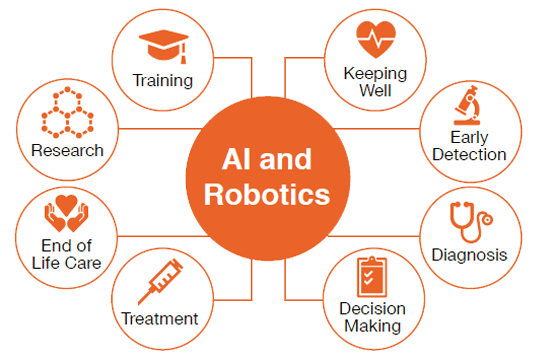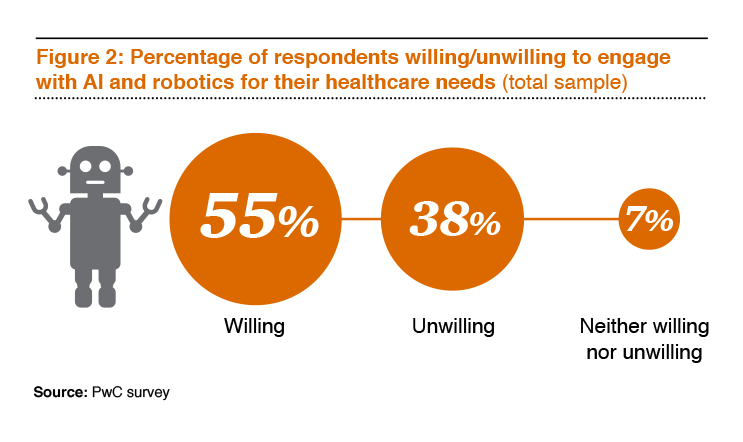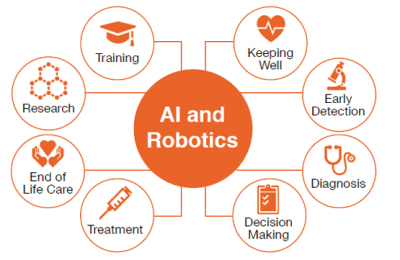
“What doctor?” asks the title of a PwC report on the emergence of artificial intelligence (AI) and robotics in healthcare.
AI and robot technology are penetrating all aspects of the macroeconomy, and they’ve begun to re-shape the health economy, as well. Underneath PwC’s titular question are two lenses: the role of the AI/robot doctor vis-a-vis the role of the human doctor.
PwC identifies eight areas that AI and robotics will impact in healthcare, shown in the first diagram:
- Decision making
- Diagnosis
- Early detection
- End of life care
- Keeping well
- Research
- Training, and
- Treatment.
For keeping well, AI and robotics can be used to support and sustain peoples’ healthy behavior through the use of wearable technology (such as performance apparel and the ubiquitous wristbands that track activity) and personal genetic profiles that provide data that can be analyzed in algorithms and fed back to consumers in the form of advice. Wearable tech can also underpin AI’s and robotics’ role in early detection. In diagnosis, AI helps make sense of unstructured (sometimes called dark). Decision-making can be augmented through AI’s ability to do predictive analytics. Treatment can be extended with the aid of robotics of all sorts, coming from innovators like Toyota (which has created robots to help immobilized patients walk), and Aethon, whose TUG robots transport materials (such as food and prescriptions) through hospital hallways to patients at the bedside. Research, long plagued with double-digit year lead-times, can be turbocharged with the infusion of AI for analyzing huge datasets for drug discovery. Training is enhanced by both AI and robotics, where the former is showing promise in virtual reality for education, and the latter for augmenting surgical skills.
What of end-of-life care (a subject with which Health Populi is long-term concerned)? Robots have an obvious role to play to help people age at home and provide support for dementia, heart failure, and osteoporosis, PwC notes.
 With all that promise, will AI and robots replace the consultation, PwC starkly wonders? The response lies in both what’s technically possible but also what clinicians themselves, as well as patients, consumers and caregivers want. The survey found that 55% of people are willing to engage with AI and robots for healthcare needs. This splits into a Mars versus Venus difference of more men (46%) compared with 32% of women.
With all that promise, will AI and robots replace the consultation, PwC starkly wonders? The response lies in both what’s technically possible but also what clinicians themselves, as well as patients, consumers and caregivers want. The survey found that 55% of people are willing to engage with AI and robots for healthcare needs. This splits into a Mars versus Venus difference of more men (46%) compared with 32% of women.
Underneath a general willingness to engage with AI or robotics in health, certain services are more attractive than others. The most desired healthcare services people are amenable to receiving with augmented AI or robotics are for:
- Monitoring heart conditions
- Administering a test for heart rhythm with recommendations based on the results
- Providing customized advice for fitness and health based on personal preferences and health records, and
- Taking and testing blood samples, providing results.
PwC’s report is based on a global survey conducted by YouGov among 11,086 adults in November 2016. Note that the consumer sample was based in EMEA countries (Europe, Middle East, and Africa).
Health Populi’s Hot Points: While PwC’s survey did not include a US sample, there are general lessons to be drawn for the growing adoption of AI and robotics in American healthcare. These trends are already in motion in the growing value-based environment. Several converging drivers support the continued expansion of these technologies for healthcare:
- Healthcare payment reform is a market-based reality in the U.S., with value-based payment expected to grow according to an analysis from the Healthcare Financial Management Association published in May 2017; being paid less for doing more requires working smarter, not harder, and AI and robotics can help do that
- Faster diagnoses and greater accessibility to treatments can be fostered by AI and robotics, helping to extend care to safety net populations who have been marginalized by the healthcare system with health disparities
- The need to improve patient safety through better, more personalized prescribing regimens and improve care flows to prevent adverse events, as evangelized by Dr. Donald Berwick.
Finally, patients – now healthcare consumers – expect a 21st century healthcare system that’s effective, efficient, accessible, convenient, and technologically state-of-the-art. Consumers will increasingly look for AI and robotics, which consumers already appreciate in the form of their Roomba vacuum cleaners and Alexa voice-responsiveness, to be baked into their healthcare.





 Interviewed live on BNN Bloomberg (Canada) on the market for GLP-1 drugs for weight loss and their impact on both the health care system and consumer goods and services -- notably, food, nutrition, retail health, gyms, and other sectors.
Interviewed live on BNN Bloomberg (Canada) on the market for GLP-1 drugs for weight loss and their impact on both the health care system and consumer goods and services -- notably, food, nutrition, retail health, gyms, and other sectors. Thank you, Feedspot, for
Thank you, Feedspot, for  As you may know, I have been splitting work- and living-time between the U.S. and the E.U., most recently living in and working from Brussels. In the month of September 2024, I'll be splitting time between London and other parts of the U.K., and Italy where I'll be working with clients on consumer health, self-care and home care focused on food-as-medicine, digital health, business and scenario planning for the future...
As you may know, I have been splitting work- and living-time between the U.S. and the E.U., most recently living in and working from Brussels. In the month of September 2024, I'll be splitting time between London and other parts of the U.K., and Italy where I'll be working with clients on consumer health, self-care and home care focused on food-as-medicine, digital health, business and scenario planning for the future...